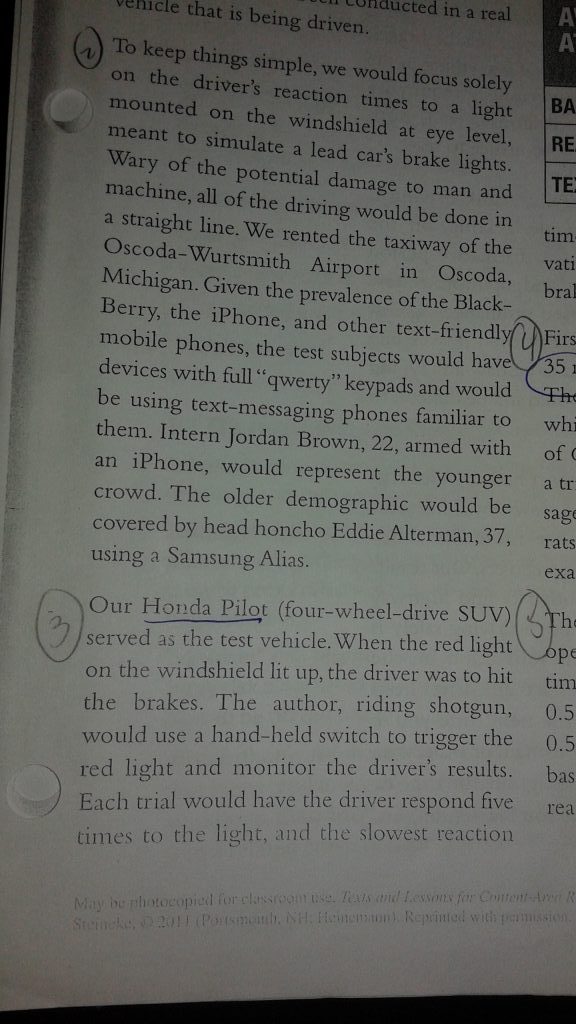Reading Strategies 1: Starting Points – Recall
Over the years, I’ve encountered many students who read beautifully when asked to read out loud. They rarely stumble over a word. They read with good pacing and expression. They are simply a delight to listen to, and they’re proud of their ability to read orally with grace and confidence. Some of these students, however, cannot recall what they’ve read almost as soon as they’ve finished reading.
ORAL READER OR SILENT READER? DO WHAT WORKS FOR YOU
The first question I have for these students is whether they tend to recall the story or information better when they read silently or aloud. Each person is different, and it’s OK, perfectly wonderful in fact, to figure out which is best for YOU. If you tend to recall text information better when you read silently in your head, please please please – do that! If you, on the other hand, remember the ideas you’ve read about better when you’ve read out loud, please, please, please DO THAT! While it may not be possible to read out loud at all times, when you can read in a whisper (in class, for example) or read loudly (at home, for example). Do what works best for you.
STRATEGIES TO IMPROVE RECALL
There are still some students who have poor recall of what they’ve read no matter how they read – silently or out loud. Here are some strategies that might help you!
- Stop after every few paragraphs. Ask yourself: What was that part all about? What happened?
- Write some key ideas on a sticky note or in your journal. If you’re reading nonfiction: What information was described? What was explained? If you’re reading fiction: What action occurred? What was the character thinking? doing? saying? Was the setting described? What did the setting ‘look like’ in your mind?
- After each page, write ONE SENTENCE that sums up the page. What was the most important thing? If you had to write a title for that page – as if it was a book or movie or video game on its own, what would you call it?
- After each chapter, write the most important events or ideas in that chapter.
WHY IT WORKS
Stopping to write, or rather KNOWING you’re going to stop to write can help a reader stay focussed on the information and ideas in the text. When you know that in a few minutes you’re going to have to put something to paper, you’re more likely to stay focussed, to concentrate and to think about what you’re reading AS you are reading it.
I can hear some of you thinking, “OH NO! Now, not only do I have to READ, but I have to WRITE while I read. Double yuck!” And it’ true. This is not a strategy anyone wants to use forever, but the thing is, you won’t have to! It’s something that you will use a lot at first, until focus and recall are not as big a problem for you.
ALL READERS NEED TO STOP, THINK, RECORD
I still use this sticky note strategy of writing what I ‘recall’ when reading more difficult text, and YES, text can be difficult for even the most accomplished readers. Dense text that is full of challenging vocabulary (I like to use the analogy of the physics textbooks that gave me big, fat goosebumps in high school because I was so afraid of the content, so unsure of myself as a scientist), text that stuffs new facts and information into a few sentences like sardines in a can, text that tends to jump from one setting or time to another, one narrator to another, and text that may just be WEIRD because of the author’s voice or style.
PARAPHRASE MEANS: IN YOUR OWN WORDS
It’s important to remember that all sticky notes or notes in your journal should be in YOUR OWN WORDS! Try not to just copy off the page. Copying can be done rather mindlessly, without much attention paid to what’s being copied (I’ll bet that you could copy words in German, or Italian, or Portuguese without ever really knowing what they mean!). The whole point of this strategy is to add mindfulness to your reading, so putting ideas in your own words, or paraphrasing when you do sticky notes means that you MUST pay attention to what’s going on, you MUST understand, at least to some degree, the ideas in the text. Writing in your own words means you’ve processed the information, and now it belongs to YOU!
In order to illustrate the strategy for you, I’ll use a text we used in Grade 8 nonfiction recently called “Texting While Driving” from Car and Driver by Michael Austin, June 2009.
Here’s the text we were reading. We numbered the paragraphs to remind us to stop and think after each one. In this exercise, we wanted to record the ideas that were most important to us from each paragraph, and our purpose for reading was to understand why texting and driving is not a good idea.
And here are some of our notes. We paraphrased, selecting only the most important information for our purposes.
No one wants to use a strategy like this one for everything they read, every time they sit down to read something. However, if you have trouble remembering what you’ve read, please try the sticky note strategies in this post. I promise that you will eventually be able to drop the strategy for most of your reading. It may take some time, but it’ll happen.






